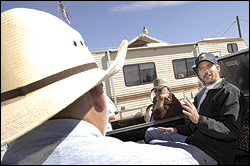The rural town of Gold Bar, on U.S. Highway 2, is a ways from the Canadian border. It is near enough, though, that resident Gary Cole, a retired management consultant who spent four years in the military, got to thinking about the problem of illegal immigration. One day, a friend went to the hospital and had to wait a long time to see a doctor. Cole blamed it on the “illegals there not paying for their services.” So when Cole heard about the Minuteman Civil Defense Corps, an Arizona-based group planning to stand guard over a desert stretch of the southern border during April, he traveled down to help. He ended up staying, becoming the group’s operations manager.
In mid-July, he returned home for a two-week recruitment effort in preparation for a similar event in October. This time, it will involve states on both the northern and southern borders, including Washington. Coincidentally last month, authorities announced they had discovered a sophisticated drug-smuggling tunnel connecting our state and British Columbia. Amid the resulting publicity, Cole says, he compiled a list of more than 100 people willing to play a hands-on role in the Minuteman Corps. Cole adds that local minuteman volunteers might take up other activities as well, such as videotaping interactions between employers and employees at day-laborer sites frequented by immigrants, a tactic used by the group in other states.
Drawing a great deal of media attention, the Minuteman Corps was denounced by everyone from civil-rights activists to President Bush, who labeled volunteers “vigilantes.” Robert Bonner, commissioner of U.S. Customs and Border Protection, suggested that citizen action on the border might be helpful, but his comments were quickly overruled by the Department of Homeland Security.
So should local illegals and wanna-be border crossers fear minutemen? Judging by the record in Arizona, probably not.
The Minuteman Corps is headed by a 44-year-old former schoolteacher named Chris Simcox. From California, Simcox became radicalized on the border issue during a backpacking vacation to Arizona one week after 9/11. He claims he saw “lines and lines of people” illegally crossing the backcountry border. Soon after, he moved to what he calls “ground zero” of illegal border traffic, Arizona’s starkly beautiful and mountainous Cochise County, bought a newspaper called the Tombstone Tumbleweed, and began organizing. His most receptive audience was retired military men.
Reached by phone at his newspaper office, Simcox insists he is “pro-immigrant.” He says of illegal immigrants, “These folks are being exploited. We need a legal way for them to enter our country with dignity and respect.” His feelings are clearly mixed, though. In addition to worrying about the terrorist threat from cross-border traffic, Simcox holds illegal immigrants responsible for a range of plagues, including outbreaks of disease among schoolchildren and a large part of the U.S. crime problem.
Simcox says his volunteers do not confront illegal immigrants. Instead, he says, his recruits set up “static observation posts” overlooking cross-border trails. They sit at those posts on lawn chairs with binoculars and cell phones, and when they see anything suspicious, they call the Border Patrol. Although many bring guns, Simcox says the guns are never drawn.
And that seems pretty much to have been the case during the April event. “There weren’t any incidents,” says Carolyn Trowbridge, a board member of the American Civil Liberties Union of Arizona, one of the most vocal critics of the Minuteman Corps. “I guess the reason why was because there weren’t that many of them,” she says of the volunteers. While the group claimed around 1,000, Trowbridge says it was more like 100 to 150. That corresponds with the estimate of Jose Garza, a Border Patrol spokesperson, who said he “didn’t see more than two to three hundred people—and half of those were media.”
There was indeed something of a circus quality to the event. In attendance were the press, the minutemen, and a group of some 80 observers concerned about the minutemen’s activities. Everybody was watching each other, not to mention the border. Plus, the Border Patrol and other law enforcement agencies kept extra staff on hand to guard everyone’s safety. Even Mexican authorities got into the act, beefing up military patrols on that side of the border. With all those eyes around, illegal immigrants stayed away from that stretch of the border, and they have continued to do so. Border Patrol apprehensions in that area are down by about half of what they were last year.
Perhaps the event’s tame quality is why folks up here don’t seem all that worked up about the imminent arrival of the minutemen. “As long as there’s no disruption with what we do, I’m not seeing an issue here,” says Joe Giuliano, deputy chief of the Border Patrol’s Blaine sector. Hilary Stern, executive director of Casa Latina, a nonprofit that runs a Belltown day-laborers site, calls potential videotaping of activities “really not a big deal.” The site has been videotaped many times before. She tells Casa Latina organizers, “If you see people videotaping, get out the digital camera and take pictures of them.”








